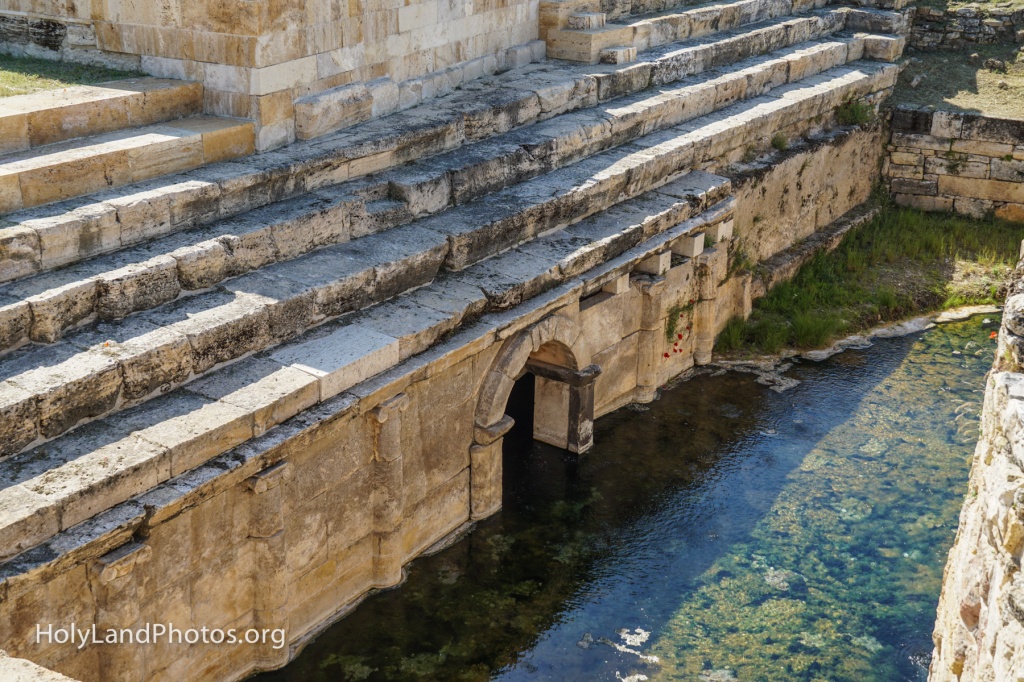In March 2013, Francesco D’Andria, professor of classic archaeology at the University of Salento and excavator at Hierapolis announced that he had excavated the, well–known to ancient authors, Plutonium at Hierapolis—which was thought to be the gate to the Underworld. For many years since then, as we visited Hierapolis (Colossians 4:13) I would look longingly into the excavated area which was firmly closed off by a secure fence!@#$#@! They even had the walkways and signage in place—but no entry was allowed.
This past spring (2023) I was very excited to find that the Plutonium was now open!

Note the rectangular pool that today is filled with thermal water. On the left (east) wall of the pool, there is an arched opening. According to the excavator, noxious gases were (are?) emitted from this opening—and this was the “gate to hades“! This arched way is flanked on both sides by a “colonnade” of pilasters in the Ionic order.
The pool was surrounded on three sides by stone benches on which worshipers would sit and observe the rituals taking place around and below them. The benches are well preserved in the foreground (north), and on the left (east), but are largely missing on the far side (south) of the pool.
Above the pool, on the left, is a replica of the large statue of Pluto and two serpents, that was found here.

View looking down at the east wall where there is an arched opening that is thought to lead to the underworld!
According to ancient authors, rites were performed at the entrance of this cave. Bulls were sacrificed by causing them to be asphyxiated by the fumes from the cave. If thermal waters also flowed from this cave, then there must have been some sort of raised platform on which the rites were performed—that is, above the water.
Various sculptures symbolic of the Underworld were found in the vicinity, including a colossal statue of Pluto (12 feet tall, see replica here), two statues of serpents, and a statue of Cerberus, the three-headed dog that guarded the entrance to the Underworld.

In the center of the photo is a shallow rectangular pool. At the far end is a door through which the bulls were led into this space to be sacrificed. In ancient times there probably was a raised platform upon which the sacrificial rites took place.
The entrance to the chamber from which the lethal fumes of Carbon Dioxide are/were emitted is on the right (east) side of the pool—visible in this image. The animals were overcome by the fumes and slaughtered.
Above the rectangular space, on the right (east) and to the north are two of the three sets of benches upon which around 800 worshipers could sit and observe the rituals taking place below and around them.
In the upper right quadrant of the photo is a full-scale reproduction of a statue of Pluto, the god of the Underworld, and two snakes. These were among other statues found in the area.
A platform is on the left (west) side of the image, above the wall that outlines the pool. The excavator says that two pools of freshwater and a round structure (tholos) were constructed there. The meager outlines of the foundations of these are barely visible.

This is a view of a seated statue of the god of the Underworld (Greek: Hades; Latin: Pluto).
Below him, to our left, is a statue of Cerberus, the dog that guards the entrance/exit to the Underworld— and which prevents inhabitants from leaving the realm. Often, but not always, he has multiple heads—usually three. Here he has only one head, but note the snake(s) wrapped around his body and his paws.
According to the sign in the museum, the statue dates to the second century A.D. and was found in the theater of Hierapolis.
It looks very much like it was the basis on which the replica statue that towers over the Plutonium was constructed.
For a description of Hades/Pluto see the Wikipedia Article. Hades. (2023, May 24). In Wikipedia. https://en.wikipedia.org/wiki/Hades
For a very vivid description of the rites that took place at the Plutonium see chapters 3 and 4 in Stanley, Christopher D., A Bull for Pluto — Book Two in the A Slave’s Story Trilogy. Second Edition. Buffalo, New York: NFB Publishing, 2020. Stanley’s novels are masterfully done and are based upon the latest archaeological finds (including this one) and ancient literature.
For additional photos of the new (and old) Plutonium see Here.

This is really great information and lovely pictures! Thanks so much for sharing this with us, Carl!